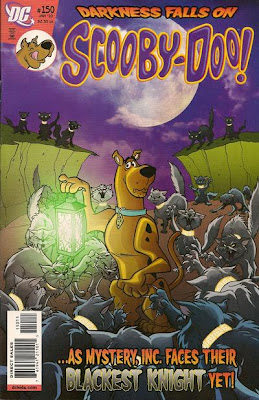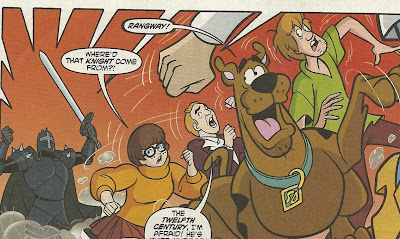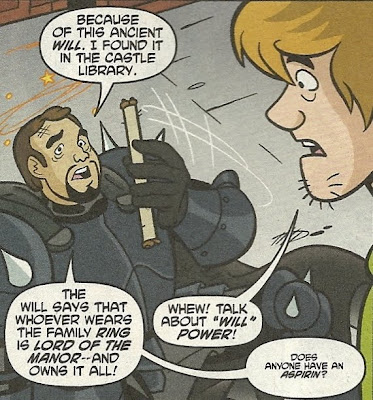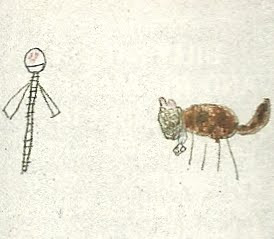 Archie #609 (Archie Comics)
Archie #609 (Archie Comics) I don’t read very many Archie comics (In fact, I haven’t read one since the
last time I noticed Josie and the Pussycats were guest-starring in an issue), so I was surprised to learn that apparently Betty and Veronica are such possessive psychos that they can never learn that Archie actually loves someone other than them or all hell will break loose?
This issue, which follows Archie and Valerie’s kiss on the eve of the Archies/Pussycats tour, consists of the young lovers trying to keep their romance on the DL so Archie’s warring would-be-lovers don’t destroy the tour itself, and everyone in Riverdale eventually finding out on their own, but vowing to themselves to keep it a secret, less Veronica and/or Betty wreak terrible vengeance upon Archie.
That’s kind of weird.
Batman: The Brave and the Bold #17 (DC) I loved this comic book so much that when I saw it on the shelf earlier today, my hand automatically grabbed it and added it to my stack,
despite the fact that I bought it the last time I was in a comics shop. I guess my love for
Batman: The Brave and the Bold #17 so deeply impressed itself on my unconscious mind that I just grab at it whenever I see it now? Well, I’m not going to re-review it. If you’d like to re-read a review of it, you can do so
here.
 Batman: The Return of Bruce Wayne #2
Batman: The Return of Bruce Wayne #2 (DC) The first issue of this Grant Morrison-written, six-issue miniseries about Batman recovering from having been “killed” by Darkseid in
Final Crisis seemed to promise a pretty straightforward premise—Batman was sent to the past, and would end up in the present by fighting his way through his own family tree, stopping in various time-periods to briefly Batman* there. That first issue was very well-executed, and an awful lot of fun.
With this issue, though, it becomes clear that this isn’t going to be a comic book series that’s
just about Batman fighting crime in period costumes for six issues. Instead, it’s shaping up to be the single most cosmic Batman story ever told, more cosmic than Morrison’s own
JLA stories (which usually featured Batman quite prominently), or
Cosmic Odyssey, and ensemble series featuring Batman that had the word “Cosmic” right there in the title.
It seems that Darkseid’s plans to create an army of Batman clones during
Final Crisis wasn’t the DC god of evil’s
only plans for Batman. He
also managed to weaponize Batman, or, in Superman’s words, Darkseid turned Batman into a doomsday weapon and aimed him directly at the 21st century!
Can Batman out maneuver the god of evil
and Superman, Rip Hunter and their posse
and return to the present? Yeah, I assume so, but holy crap that’s a big, huge Batman story, one that necessitates him fighting “crime” on a colossal scale, as we see him here doing his thing in pilgrim times
and at the end of time itself.
There is a
lot going on in this issue, beyond the main course, which involves Batman sword-fighting a Lovecraftian monster and using his detective skills to bust witches while dressed like Solomon Kane. I have no idea how it’s all going to shake out, but the history of Gotham, the Wayne bloodline, Batman’s relationship with bats and the sigils of the superheroes are apparently part of the story.
Frazer Irving is the artist for this issue, and having previously illustrated a Morrison-written comic book featuring people in pilgrim clothes (
Seven Soldiers: Klarion The Witch Boy), he’s a pretty good choice for the issue. I’m not terribly enamored with his art, although it is technically quite good. Irving seems better at atmosphere than place, which occasionally results in panels or pages that err on the side of expressive, sacrificing clarity.
He draws wonderfully grim visages though, and the scenes at Vanishing Point, the high-tech headquarters at the end of time, where a 64th century bio-organic archivist explains the nature of time to Superman’s search party are quite effectively alien.
Billy Batson and the Magic of Shazam (DC) Four issues of Black Adam and Captain Marvel punching one another is probably a bit excessive Art Baltazar and Franco, no matter how cool the new style Mike Norton has adopted for this series may be. I suppose it’s a byproduct of DC’s kid-friendly comics always being done-in-ones, but this multi-issue story arc has seemed interminable.
On the other hand:

Ha! I love the ankh-clamation point!
 Ghost Rider: Hell Bent & Heaven Bound
Ghost Rider: Hell Bent & Heaven Bound (Marvel Comics) This trade paperback did
not come out last Wednesday, but I did purchase it at the shop during this shopping trip, so by the rules of this feature I’ve set up for myself, that means I should discuss it here.
The shop I currently shop at does this swell thing where they give you a coupon for your birthday that gives you a 25% discount on any trade. Mine was about to expire, and they didn’t have my first two choices for trades I’d like to buy, so I figured now might be a good time to try out the Jason Aaron run of
Ghost Rider that the Internet was so enamored with.
It is every bit as good as I heard it was.
This six-issue collection contains two different stories—the title story, illustrated by Roland Boschi, and “God Doesn’t Live on Cell Block D,” illustrated by Tan Eng Huat.
Ghost Rider Johnny Blaze, a kinda sorta superhero whose power is the ability to turn into a flaming skeleton on a flaming motorcycle, wants to find a way to get to heaven in order to wreak revenge on the rebel angel that cursed him with his flaming skeleton powers.
In the first story, he travels to the town of New Beulah to find someone who had a near death experience and might be able to help Blaze get to heaven. That town is home to a hospital full of armed-to-the-teeth killer nurses. And a mortician who also happens to be a cannibal. And a stretch of highway haunted by the hungry ghosts of cannibal frontiersmen.
In other words, Aaron thinks up some really crazy plates, sets them all spinning and then just smashes them all together at the climax. Actually
smashing them all together is the plot of the final issue, as the characters from those various subplots all participate in a horrible accident at a four-way intersection that could really use some stop signs.
It’s a trashy heavy metal horror western with some Garth Ennis-style touches of dark absurdity and some awesomely over-the-top deadpan nonsense (I’m thinking, for example, Ghost Rider with a flaming sword, saying “Suck it!” to his foes).
The two-issue follow-up is a much calmer, quieter story, one that benefits from Huat’s extremely weird cartoony art, which evokes a little Sam Kieth here, a little
Judge Dredd there. It was Huat’s byline that attracted me to the collection (well, that and all the rave reviews I’ve read of these comics from bloggers whose opinions I often agree with), but I ended up liking Boschi’s art better, as it’s far closer in style to that which I think of when I think of Marvel Comics art I want to read (John Romita Jr., Marcos Martin, etc).
Like Aaron’s Wolverine comics then, his Ghost Rider seems to be pretty great. I look forward to reading the rest of it, hopefully sooner rather than later.
 Green Lantern #54 (DC)
Green Lantern #54 (DC) This comic book has a scene where someone has all of their flesh and tissue burned right off their skeleton. It’s written by Geoff Johns. Is that redundant to mention both of those facts?
The extreme gross-out gore sits surprisingly well with me here because a) it’s drawn by Doug Mahnke, whose such a great artist that he packs detail into a crumbling human skeleton and makes it look like an object of beauty rather than something merely disgusting and b) the agency which melts the human being is the burning napalm-like blood-puke puked up on him by a house cat wearing a Red Lantern uniform with a Red Lantern ring on its tail, and that’s the exact brand of stupid awesome that I read Geoff Johns comics for.
This issue doesn’t move all that quickly from where we left off last time. It was clear that the White Lantern was going to ask Hal, Carol and Sinestro to get the band back together for a quest, and here they join up with the main Red Lantern. Apparently, they’re reassembling the, um, “rainbow rodeo,” I believe Hal Jordan called it, to find the Pokemon-like hero-gods of Earth evolution before they little flying mummy midget in chains can get ‘em all—and he/she/it already has two of ‘em!
Before they get to all that though, it looks like they’re going to have to fight Lobo, according to the last-page splash. After having just recently read
Reign in Hell, I’m not sure exactly how Lobo got from that Point A to Point
Green Lantern #54, but I don’t really care because a) Doug Mahnke draws a hell of a Lobo and b) he has his space bulldog on the back of his space bike, which makes a burning blood-puking space cat vs. super space bulldog fight inevitable, and that’s exactly what I’d like to read about in a
Green Lantern comic book.
 Justice League: Generation Lost #2 (DC)
Justice League: Generation Lost #2 (DC) So far, so good! Writers Keith Giffen and Judd Winick explain the lingering question of how Max Lord could erase all clues of himself from the Internet and libraries of the world right out of the gate, and rather cleverly (the evidence all exists, but he was able to alter everyone’s memories enough that when they see the evidence, they perceive something else). That makes two Judd Winick comics in a row that I’ve read and
not hated!
The other thing I was little concerned about was the presence of pencil artist Joe Bennett this issue, whose work I haven’t really enjoyed in the past, but it looks far better here than in any of the previous books of his I’ve seen. I’m not crazy about his style—he was a tendency to draw very small faces, and it’s sort of irritating that Fire and Ice have the exact same body, right down to their height—but it seems slightly simplified, with inker Jack Jadson providing a lot of nice lines to sell almost every panel.
I don’t
love the look of the art, but it’s not bad, and it really pops. So that takes care of my concerns; I’m down for
Generation Lost #3, I guess.
If I have any complaints to make here, it’s more of a nitpick of an omission. I know we’re only two issues in, but it seems strange that Booster and the others haven’t yet looked up J’onn J’onnz, since he’s the A-List superhero they all know the best, and who happens to be an expert in the sort of psychic mind-messing with that Max Lord, who J’onnz
also knows super-well, is engaging in. The Martian Manhunter being MIA is made noticeable only because the first half of this issue deals with the heroes formerly known as the Justice League checking in with Superman, Batman, Wonder Woman and, in a sequence of cameos, nine different heroes, including Plastic man and Captain Shazam (or whatever Winick is calling the superhero formerly known as Captain Marvel Jr. these days).
That aside, this is a boatload of DC Universe heroes bouncing around a bi-weekly book. The writing isn’t bad, and the art isn’t bad either. In other words, this book’s good enough.
 Super Friends #27 (DC)
Super Friends #27 (DC) This is another J. Bone-drawn issue of the series, which automatically makes it a must-buy for me, because
every image J. Bone draws for this comic book is a great one, his Super Friends characters always having silly, emoticon-simple faces that crack me up no matter what else is going on in the story.
This ish, written by Sholly Fisch (who also wrote that swell issue of the
Brave and the Bold I accidentally bought twice, and
the Scooby/Geoff Johns team-up I blogged about last night), has plenty of other things going for it, of course.
Green Lantern John Stewart and Flash Wally West both have birthdays the same week, and both want to throw the other a surprise party for the other in the same place and on the same day. What are the other Super Friends going to do? Well, the point is moot, since Sinestro and Professor Zoom, The Reverse Flash have a surprise of their own for their archenemies.
This one’s got it all. Sinestro and Zoom in disguise as GL and Flash, giving each other daps...

...a make-your-own Green Lantern Corps mobile craft project...

...guest stars galore...

...and, most amusingly, Superman making this face:

It's those expressions that make me love all of Bone's
Super Friends comics.
 The gang are driving around Paris in the Mystery Machine and…wait. What are they doing in the Mystery Machine in Paris? You can’t drive to Paris, on account of the Atlantic Ocean. Did they pay to have the Mystery Machine shipped to France, just so they could drive it around Paris? Wouldn’t it be cheaper to simply rent a car there? Or to take cabs? Why are they driving their van in Paris?! How did it get there? Now this, this is a mystery!
The gang are driving around Paris in the Mystery Machine and…wait. What are they doing in the Mystery Machine in Paris? You can’t drive to Paris, on account of the Atlantic Ocean. Did they pay to have the Mystery Machine shipped to France, just so they could drive it around Paris? Wouldn’t it be cheaper to simply rent a car there? Or to take cabs? Why are they driving their van in Paris?! How did it get there? Now this, this is a mystery!


 I know I noted that these comics tend to be more for kids than for an all-ages audience, and the quality of the jokes fairly sub-par, but I have to admit I liked the bit where Scooby holds out his paw to get kissed and Gaston Librevou totally ignores him.
I know I noted that these comics tend to be more for kids than for an all-ages audience, and the quality of the jokes fairly sub-par, but I have to admit I liked the bit where Scooby holds out his paw to get kissed and Gaston Librevou totally ignores him.
 ...Velma’s so tiny all of a sudden!
...Velma’s so tiny all of a sudden! Cool, huh? Apparently we’re operating under the pop culture phenomenon that glasses automatically equals unattractive, while the absence of glasses automatically equals pretty. Looking aback and forth between the Two Velmas Matchette has drawn, there doesn’t seem to be much difference other htan the glasses. Her eyes are drawn differently, her hair less helmet-like and she’s got lipstick, which suggests the presence of lips absent from her normal look.
Cool, huh? Apparently we’re operating under the pop culture phenomenon that glasses automatically equals unattractive, while the absence of glasses automatically equals pretty. Looking aback and forth between the Two Velmas Matchette has drawn, there doesn’t seem to be much difference other htan the glasses. Her eyes are drawn differently, her hair less helmet-like and she’s got lipstick, which suggests the presence of lips absent from her normal look. 
 ... bringing them all down in a chain reaction, and the mystery is solved...
... bringing them all down in a chain reaction, and the mystery is solved...












































